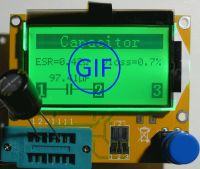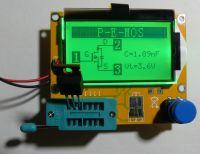LCR-T4 electronics components tester ATMega328 - Test and Review
The tester automatically detects the type and layout of the lead leads of the connected component, and displays the measured parameters of the tested part. The tester is powered by 9V battery and during the measurement it draws current 12-15mA, while in sleep mode it draws current 20nA.
Connect the test components to the three random (or two) available leads, the measurement starts when you press the button. Discharge the tested capacitors before capacity measurement. After unpacking the new tester, carry out the calibration, we do it by connecting the 1-2-3 lead wires with minimal resistance (e. g. with two jumpers made of silver or unnecessary resistor tips). Press the microcircuit button and start calibration, at 38% we will be asked to remove jumpers, at 82% we connect to 1-3 pre-prepared capacitor leads with capacity greater than 100nF.
Type of elements tested and parameters checked:.
capacitors: capacity 25pf-100 000uF, ESR, Vloss
bipolar NPN, PNP transistors: hFE, Uf
MOSFET field resistors N channel, channel P: gateway threshold voltage and capacity
JFET connector field resistors: Vgs, I
Dual diodes and dual diodes: conductive voltage and capacity
Resistors, resistance measurement of two resistors simultaneously: up to 50M?
Inductance 0.01mH-20H and winding resistance
thyristors, triacs
You can find such possibilities in the description, but it is worth checking it yourself.
Since one picture is better than many words, below the animated gif with test results of LEDs, bipolar and field transistors, thyristor, resistors, capacitors and inductance, at the end of this text you will also find video from the device tests.

The accuracy of the M328 tester compared to the multimeter is very good.
The first column is informatively the type of element to be tested, the second column is the multimeter measurement result, the third column is the multimeter measurement uncertainty, the fourth column is the tester's measurement result, and the fifth column is the difference between multimeter and tester indication.
Where the difference was at least 10x greater than the measurement uncertainty, I entered the percentage difference from the multimeter and the tester result. The Sanwa PC500a multimeter and the UT58D multimeter were used to measure resistance and capacitance.
An error is visible when measuring low resistance of inductive elements, and when measuring voltage drop on the honey (probably the tester examines diodes with a different current than the multimeter and therefore differences appeared).
I am curious what is the scattering of the parameters and what accuracy the rest of the tester will obtain, if you will carry out the tests with your testers, please write in this topic what results you have achieved. I would be happy to familiarize myself with your opinion about this useful device, which in my opinion will be useful in every workshop.
Connect the test components to the three random (or two) available leads, the measurement starts when you press the button. Discharge the tested capacitors before capacity measurement. After unpacking the new tester, carry out the calibration, we do it by connecting the 1-2-3 lead wires with minimal resistance (e. g. with two jumpers made of silver or unnecessary resistor tips). Press the microcircuit button and start calibration, at 38% we will be asked to remove jumpers, at 82% we connect to 1-3 pre-prepared capacitor leads with capacity greater than 100nF.
Type of elements tested and parameters checked:.
capacitors: capacity 25pf-100 000uF, ESR, Vloss
bipolar NPN, PNP transistors: hFE, Uf
MOSFET field resistors N channel, channel P: gateway threshold voltage and capacity
JFET connector field resistors: Vgs, I
Dual diodes and dual diodes: conductive voltage and capacity
Resistors, resistance measurement of two resistors simultaneously: up to 50M?
Inductance 0.01mH-20H and winding resistance
thyristors, triacs
You can find such possibilities in the description, but it is worth checking it yourself.
Since one picture is better than many words, below the animated gif with test results of LEDs, bipolar and field transistors, thyristor, resistors, capacitors and inductance, at the end of this text you will also find video from the device tests.

The accuracy of the M328 tester compared to the multimeter is very good.
The first column is informatively the type of element to be tested, the second column is the multimeter measurement result, the third column is the multimeter measurement uncertainty, the fourth column is the tester's measurement result, and the fifth column is the difference between multimeter and tester indication.
| component | multimetr | uncertainty +/- | tester | difference | resistor | 118 | 0,54 | 117,3 | 0,7 | resistor | 9,97k | 0,04k | 10,18k | 0,21k (2%) | resistor | 99,4k | 0,4k | 99,12k | 0,28k | resistor | 1,518M | 0,02M | 1,521M | 0,003M | resistor | 10,11M | 0,2M | 10,17M | 0,006M | choke | 0,107mH / 0,08 | 0,012mH / 0,06 | 0,10mH / 0,7 | 0,007mH / 0,62 (775%) | choke | 5,14mH / 8,44 | 0,2mH / 0,09 | 5,23mH / 8,9 | 0,09mH / 0,46 (5%) | choke | 9,83mH / 14,42 | 0,3mH / 0,12 | 10.2mH / 15,0 | 0,37mH / 0,58 (4%) | capacitor | 0,28nF | 0,03nF | 0,277nF | 0,003nF | capacitor | 4,70nF | 0,07nF | 4,854nF | 0,154nF | capacitor | 99,5nF | 1,1nF | 103nF | 3,5nF | capacitor | 983nF | 0,01nF | 1013nF | 30nF (3%) | capacitor | 100uF | 4uF | 99,63uF | 0,37uF | capacitor | 985uF | 54uF | 968,1uF | 16,9uF | diode | 0,555V | 0,007V | 0,683V | 0,128V (23%) | diode | 0,250V | 0,004V | 0,339V | 0,089V (35%) |
Where the difference was at least 10x greater than the measurement uncertainty, I entered the percentage difference from the multimeter and the tester result. The Sanwa PC500a multimeter and the UT58D multimeter were used to measure resistance and capacitance.
An error is visible when measuring low resistance of inductive elements, and when measuring voltage drop on the honey (probably the tester examines diodes with a different current than the multimeter and therefore differences appeared).
I am curious what is the scattering of the parameters and what accuracy the rest of the tester will obtain, if you will carry out the tests with your testers, please write in this topic what results you have achieved. I would be happy to familiarize myself with your opinion about this useful device, which in my opinion will be useful in every workshop.




Comments
There is no information for how many points this instrument will be available. Maybe you already know? [Read more]
I had and used this tester - it worked well, now I gave it to my father, and I use the newer one on a colored display with a built-in battery. [Read more]
This model has no protection, eg before a charged capacitor, it would be useful for HEX to be available for this model in case of [Read more]
It would be useful in the workshop. The most useful is probably the measurement of inductivity. I could knit my own coils based on electronic scrap. Most cores are no-name so the inductance of such a coil... [Read more]
I have such a modified T4 yolk. There is even a topic about this model with us on the forum. Very interesting equipment, with quite nice features and generally sufficient accuracy in amateur applications.... [Read more]
And as with the accuracy of this white color LCD compared to the yellow one that was presented by TechExpert's colleague :) ? [Read more]
http://www.ebay.pl/itm/LCR-T4-LCR-T5-GM328A-M328-M328LCD-MK-328-MK-168-TS-M8N-EZM328-Transistor-Tester-/162449094712?var=&hash = item25d2b87838: m: mhnYBVFs3gY23RwV2vp9KxA Various, you can choose at will... [Read more]
These testers are based on the same design and the differences are only in the displays used and in the power supply method, eg a 3.7V type 14500 battery. http://obrazki.elektroda.pl/9545752600_1498692635_thumb.jpg... [Read more]
For me, the accuracy of measurement is - it is sufficient. He treats it as a tester, if the elements are operational - in multimetrs I had, I did not have the large capacity measurement - here 47.000 uF... [Read more]
Hello. We just recently acquired a few such ready-made products in the cabinet, as presented on the photo @mozekam, only marked T7. How I suppose a newer version, although it looks the same from the outside.... [Read more]
I bought it on Aliexpress - it was 3 weeks, I'm also impressed - the price is less than 30 $ - it has earned itself with a vengeance. Generally, now for Aliexpress, the electronics is a real mine -... [Read more]
Mostly it would be useful to make your own coils / chokes as already mentioned. Please correct the error in the table (775%) ??? Because he's hurting his eyes. :) [Read more]
Mainly for making coils / chokes? Well, unless someone has such a major hobby ;) After all, toto can detect (!) And measure (!) Almost any discrete elements from the electronics drawer (or repaired customer's... [Read more]
link The colleague has already developed and expanded this system. ;) [Read more]
Does anyone know for what period of time will you get that tester and how many pieces will it be? [Read more]
Do you want to receive this visit regularly shop :) Gulson does not say how many pieces he "throws at the store" and how long it will depend on the demand. The first batch of USB Keweisi KWS-V20 spread... [Read more]
Just to be clear: You are now writing about the device from the first post of the topic. I wrote about a different model, "ready", containing already option to test Zener diodes, IR remotes, battery and... [Read more]
Shop with gadgets: link [Read more]
I did not know that there is a "color" version of this tester :) @mozekam great, the comparison is always useful. @ HD-VIDEO do you have a link to the DIY version of this construction... [Read more]